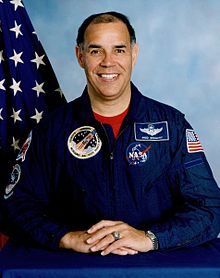Colonel Frederick D. Gregory was the first African-American to pilot a spacecraft.
Born January 7, 1941, in Washington, D.C. to Francis A. Gregory and Nora Drew Gregory, he graduated from Anacostia High School, in Washington, in 1958 and entered the United States Air Force Academy where he studied military engineering and received a bachelor of science degree from in 1964.
Since childhood, he had a passion for speed, racing a small aluminum boat in waters off Columbia Beach near Washington, D.C. He says, “I always wanted to fly.”
After graduating from the United States Air Force Academy in 1964, Gregory entered pilot training and attended undergraduate helicopter training at Stead Air Force Base, Nevada. He received his wings in 1965 and was assigned as an H-43 helicopter rescue pilot at Vance AFB, Oklahoma, from October 1965 until May 1966. In June 1966, he was assigned as an H-43 combat rescue pilot at Danang AB, Vietnam. When he returned to the United States in July 1967, he was assigned as a missile support helicopter pilot flying the UH-1F at Whiteman AFB, Missouri.
In January 1968, Gregory was retrained as a fixed-wing pilot flying the T-38 at Randolph AFB, Texas. He was then assigned to the F-4 Phantom Combat Crew Training Wing at Davis-Monthan AFB, Arizona. Gregory attended the United States Naval Test Pilot School at Patuxent River Naval Air Station, Maryland, from September 1970 to June 1971. Following completion of this training, he was assigned to the 4950th Test Wing, Wright Patterson AFB, Ohio, as an operational test pilot flying fighters and helicopters.
In June 1974, Gregory was detailed to the NASA Langley Research Center, Hampton, Virginia. During his time there, he earned a master’s degree in information systems from George Washington University in 1977. He served as a research test pilot at Langley until selected for the Astronaut Program in January 1978. After his selection as an astronaut and subsequent training, Mr. Gregory flew three shuttle missions, making history with two.
STS-51B/Spacelab-3 launched from Kennedy Space Center, Florida, on April 29, 1985 with Colonel Frederick D. Gregory as pilot, becoming the first African-American to pilot a spacecraft. The crew aboard the Orbiter Challenger included spacecraft commander, Robert Overmyer; mission specialists, Norman Thagard, William Thornton, and Don Lind; and payload specialists, Taylor Wang and Lodewijk Vandenberg. On this second flight of the laboratory developed by the European Space Agency (ESA), the crew conducted a broad range of scientific experiments ranging from space physics to the suitability of animal-holding facilities. The crew also deployed the Northern Utah Satellite (NUSAT). After seven days of around-the-clock scientific operations, Challenger and its laboratory cargo landed on the dry lakebed at Edwards AFB, California, on May 6, 1985.
